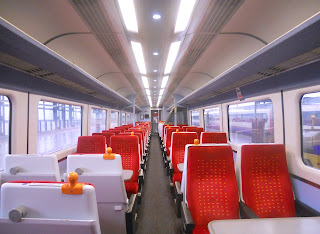Peter Skuce - Midland Mainline 4A
PART 1. During 1959 and the early 1960s, British Railways modernised suburban passenger services on the first fifty miles of the Midland Main Line between London St Pancras, St Albans, Luton and Bedford with the construction of thirty, 4 carriage length Class 127 Diesel Multiple Units powered by Rolls Royce engines coupled with Hydraulic transmission. Each four carriage train seated 274 passengers in Standard Class with two toilets in one intermediate trailer vehicle. A new depot was constructed at Cricklewood to maintain and repair the trains. They directly replaced the ageing steam locomotive hauled passenger trains and became known as BedPan units by both passengers and staff alike. Intercity services would be formed of Clsss 45 Peak Diesel Electric locomotives and rolling stock formed of both Mark 1 & Mark 2 loco hauled coaching stock.
During the late 1970s, British Rail decided to electrify the Midland Main Line for the first fifty miles from Bedford to London St Pancras and The Widened Lines to Kings Cross (Midland City) and Moorgate, as well as modernising the signalling by replacing semaphores with colour light signalling being controlled by a signalling centre at West Hampstead. The overhead line electrification team had just finished work on installing overhead line on the East Coast Main Line between London Kings Cross and Royston in 1976. The station buildings at Bedford, Luton, St Albans, Radlett and Hendon were demolished and rebuilt.
A batch of forty eight, 4 carriage length Class 317 EMU trains, to be known as ‘Midland Electric’, were constructed by BREL York. They were to be powered by four GEC G315BZ traction motors controlled by thyristors and had a maximum speed of 100 mph. The bodyside of the train, painted in Rail Blue and Grey was derived from the Mark 3 carriage, along with the interior saloon slab fluorescent lighting diffusers. The trains were fitted with pressure ventilation, which was also fitted to the Southern Region ‘First Series’ Class 455/8 inner suburban EMU train. Each train had the capacity of 270 in Standard Class to 2+3 layout and 22 in First Class to the 2+2 layout. The seat moquette trim was the same as fitted to the ill fated InterCity APT project and interestingly the seats in First Class were identical to Standard Class seats aboard the High Speed Train/InterCity 125! Again there were two toilets per a four carriage unit. The interiors were open plan and they were also fitted with end gangway connections allowing passengers to walk from one unit to the next unit. The trains would be maintained at Cricklewood, which was modified to deal with the Class 317 EMU trains.
British Rail wanted to introduce Driver Only Operation, with the driver releasing door controls and closing the doors, completely doing away with the guard. The trade unions did not like this and refused to drive the brand new Class 317 EMU trains and instead the ageing and increasingly unreliable Class 127 DMU trains continued to ply the Midland Main Line until mid 1983.
During 1983 the famous, popular, streamlined High Speed Train/InterCity 125 was introduced onto InterCity Midland Main Line services between London St. Pancras – Nottingham/Sheffield replacing Class 45 Peak locomotives and loco hauled carriages.
In June 1986, British Rail created Network South East and they drew up plans to radically change the route and create a new batch of trains – the name Thameslink was born and the new trains were to be sixty 4 carriage length Class 319/0 EMU trains. These Class 319/0 EMU trains were to be built from 1987 to 1988 and featured 319 seats all in Standard Class with two toilets and convection heating. They were in effect, a development of the Class 317 EMU train as they featured the same traction motors, however they are controlled by GTO Chopper, which made them state of the art trains at the time. Also they were the first brand new trains to carry the Network SouthEast livery on the bodyside and ‘blue blaze’ seat moquette trim as well as the first EMUs to feature Asbourne seating. These trains were also fitted with third rail shoes to enable them to work from 750 volts DC Third Rail of the Southern Region. Upon introduction of the Class 319/0 EMU trains, the Class 317 EMU trains were then cascaded onto the London Euston – Milton Keynes – Northampton – Birmingham New Street ‘Northampton Line’ and later onto the London Kings Cross – Stevenage – Cambridge/Peterborough ‘Great Northern Line’.
During 1990 twenty six, 4 carriage length Class 319/1 EMU trains were built. They had improved end deflectors, drivers cab doors and easier access into the passenger saloon by vertical poles in the vestibule doorway. The interiors were similar to the Class 321 with around 280 seats in Standard Class to the 2+3 layout and one Driving Trailer vehicle of each unit housed a First Class cabin holding sixteen First Class seats to the 2+2 layout and were transferred onto the Bedford - Luton - St Albans - London - East Croydon - Gatwick Airport - Brighton route. These trains worked the prestigious Bedford – Luton – St Albans – London – Gatwick Airport – Brighton route.
Part 2 follows tomorrow. Peter Skuce.








